
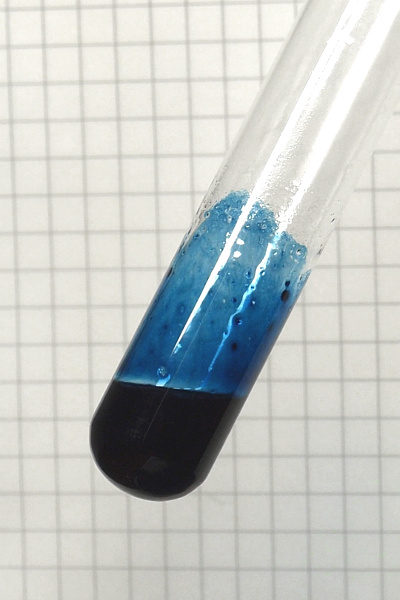

Free solvated electrons
Approximately 150 years ago, it was discovered that sodium can be dissolved in liquid anhydrous ammonia, giving a deep blue solution, while no hydrogen gas is produced. Further studies revealed that this deep blue color is caused by the presence of free electrons e−, solvated by ammonia molecules. The sodium, added to the ammonia dissolved and produces ions Na+ and e−.
For a long time it was believed that the free electron only could exist at low temperatures in liquid ammonia, but later it was discovered that certain organic amines also allow formation of free electrons, also at room temperature. Such solutions are moderately stable and can be kept around for hours. In this experiment, such a solution is produced from lithium andethylenediamine, NH 2CH2CH2NH2. Some properties are demonstrated. The deep blue color of the free solvated electrons also is prominently displayed at room temperature and in other solvents than liquid ammonia.

The picture shows a very dilute solution of dissolved lithium in ethylenediamine. This dilute solution contains ions Li+ and e−, both solvated by ethylenediamine, so it would be better to write Li(en)n+ and e(en)n−, where n is some unspecified number, and (en) stands for the ethylenediamine ligand.
![]()
![]() Required
chemicals:
Required
chemicals:
-
lithium
-
ethylenediamine (the chemical must be pure, not a solution in water)
![]() Required
equipment:
Required
equipment:
- test tubes
- small tank or dish for holding water
![]() Safety:
Safety:
- Ethylenediamine is quite a strong base, hence it is corrosive. This compound is intensely strongly fuming and has a smell reminiscent to the smell of ammonia (although it is less pungent). Avoid contact with skin and avoid inhaling the fumes.
- Lithium
is very reactive. Its reaction with water is highly exothermic. Avoid
touching the metal with bare hands, especially if your hands are wet or
somewhat sweaty. Also avoid as much as possible, contact of lithium
with air, it is oxidized very quickly.
![]() Disposal:
Disposal:
- No particularly toxic waste is produced in this experiment. The waste can be flushed down the drain with a lot of water.
![]()
Putting a piece of lithium in ethylene diamine
This experiment is a very simple one. Simply take a
piece of lithium, pea-sized or slightly larger. The picture below shows
the lithium, used in this experiment. It is shiny lithium , stored
under pressurized butane gas in a very well sealed bottle.

One such a piece of lithium (appr. 3.5 mm diameter, 8...10 mm length) was taken and put in a test tube. When this is done, then the piece quickly loses its metallic lustre and becomes covered by an oxide layer. It is oxidized by oxygen and water vapor from the air:
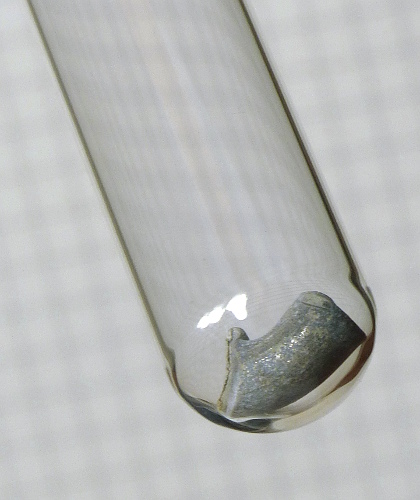
To this, appr. 2 ml of pure ethylenediamine
was added. When this is done, then first there is very slow production
of hydrogen. This almost certainly is due to the presence of a small
quantity of water in the ethylenediamine. The production of hydrogen is
very slow. The liquid also obtains a grey color with a somewhat bluish
hue.
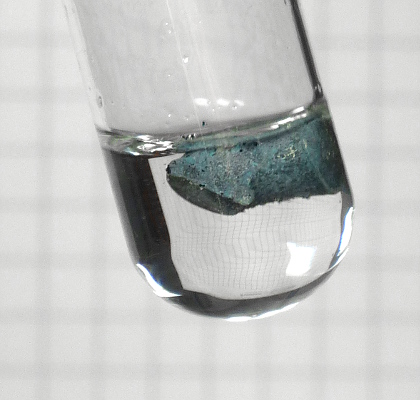
After a while, the color of the piece of lithium changes and becomes more pronounced blue/cyan. Production of hydrogen gas at this point slows down even further.
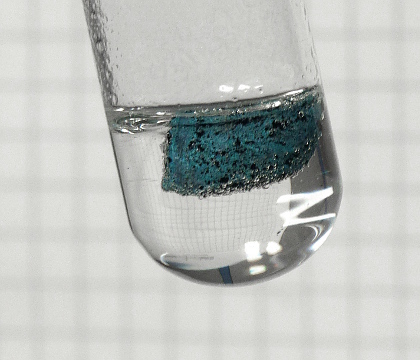
Also some solid particles appear, which
give the lithium a somewhat rough appearance. This solid material most
likely is formed while the lithium was oxidized in the air and may also
be due to impurities in the ethylenediamine. In a later stage of the
experiment, these solid particles peel off when more of the lithium
dissolves.
Formation of free solvated electrons
Once all water has been used up, free solvated electrons make it into solution, further away from the lithium metal. Initially, the blue color of the solvated electrons only can be seen very near the lithium, but in later stages, more and more of the solvated electrons are formed and remain in solution.
Initially, the electrons can only be observed transiently. Around the lithium, a fairly high concentration of free electrons is formed. The lithium is covered by a very dark blue, nearly black, layer. When the test tube is shaken vigorously, then the blue color of free solvated electrons can be observed briefly, but the color very quickly fades again, when the shaking stops. This is demonstrated by a video: transient appearance of solvated electrons. Download size is just over 3 MByte. Apparently, in the liquid there is something dissolved, which very quickly oxidizes the free electrons. This dissolved species most likely is still remaining water, which quickly reacts with the free electrons, giving hydroxide ions and hydrogen gas.
After several times of shaking the test
tube in this way, the fading of the blue color of free electrons takes
more time. At a certain point in time, the fading takes several seconds
and the process can be followed nicely. The effect is quite striking.
Each time when the test tube is swirled, the liquid becomes very dark
blue, nearly black, while at the glass wall above the liquid no color
can be observed at all, and the nearly black color fades in a few
seconds to colorless. Below follows a sequence of a few pictures, which
shows the changes over a period of 4 seconds. The time between two
images is 500 milliseconds, the first image (top left) is just after
shaking vigorously.
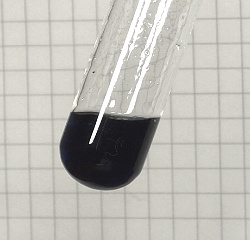
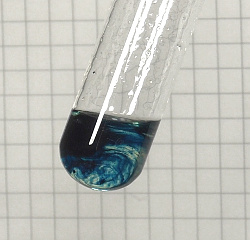
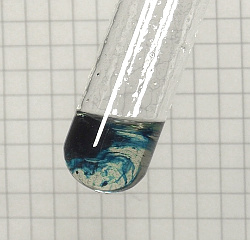
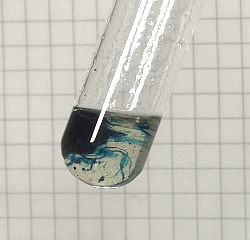
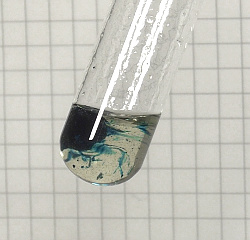
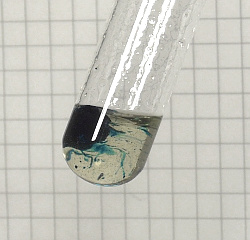
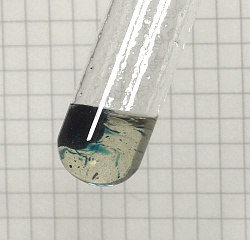
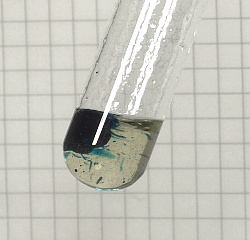
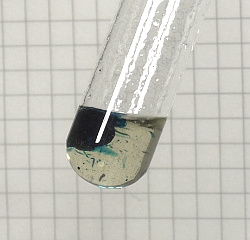
A video demonstrates this effect even better: slow oxidation of free solvated electrons.
Download size is nearly 6 MByte. The video also shows that oxidation of
the free electrons takes more time after each turn of shaking of the
test tube. The compound which oxidizes the free electrons is used up
and its concentration becomes lower and lower.
At a certain point, the color does not fade
anymore after shaking. The liquid does not contain any oxidizing agent
anymore which consumes the electrons. At this stage, there also is a
deep blue color of the liquid, sticking to the glass walls of the test
tube. This liquid, however, quickly loses color and this most likely is
due to oxidation by oxygen and/or watervapor from the air. The picture
sequence below shows the liquid, immediately after shaking the test
tube and each further picture is make exactly 1 second after the
previous one. The total sequence covers 5 seconds.




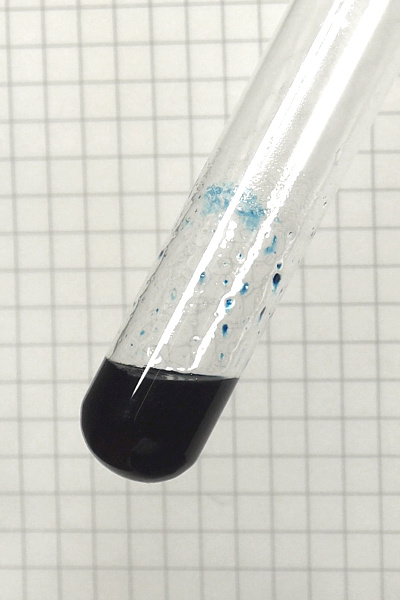
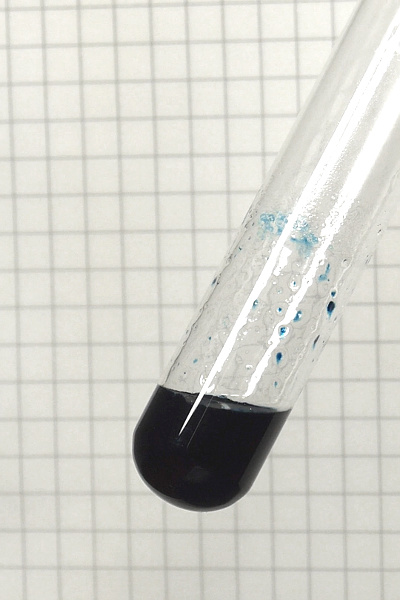
The time it takes before the color has
faded from the glass of the test tube does not change noticeably after
many turns of shaking. This is because the test tube is open and fresh
air can get in. The blue color quickly fades in contact with air, due
to aerial oxidation. A video is made of this process as well: electrons oxidized by air. Download size is nearly 6 MByte.
![]()
Free electrons in water: immediate oxidation
In this final experiment, the very dark blue liquid with the free electrons is added to water. As soon as the liquid comes in contact with water, the color disappears and a colorless solution is produced.
Finally, the piece of lithium itself is thrown in the water. It quickly dissolves, while fizzling violently. The reaction between lithium and water is quite vigorous and no traces of free solvated electrons can be observed at all in this reaction.
A video is made of this process as well: electrons oxidized by water. Download size is appr. 10 MByte.
![]()
Discussion of results
![]() In all of their reactions, alkali metals are strong reductors and frequently their reaction is written as follows:
In all of their reactions, alkali metals are strong reductors and frequently their reaction is written as follows:
M → M+ + e−
Here M is the alkali metal ion. This
usually is considered a so-called half-reaction and this reaction
equation is combined with another equation, in which electrons are
consumed, so that the net combined reaction equations have the
same charge at the left and right and have no production, nor
consumption of free electrons. This kind of equations do not describe
what happens really, but are a tool to help find the correct and
complete reaction equation in real redox reactions.
In this experiment, however, the electrons really are produced and exist as such in solution. They are solvated by the solvent, in this case ethylenediamine. So, here we have the following reaction equation, which is not merely a bookkeeping device or mathematical model, but describes what happens in reality:
Li(s) → Li+(solv) + e−(solv)
Here, (s) stands for solid, and (solv) stands for the fact that the lithium ions and electrons are solvated and can be considered as complexes with the metal ion and the free electron as central ion and ethylenediamine molecules as ligands. The solvated lithium ions are colorless and the solvated electrons have a deep blue color.
The most remarkable property of
the free electrons is that their color is independent of the solvent in
which they appear and also independent of temperature. At low
concentration, they have a deep blue color. At higher concentrations,
from appr. 0.05 mol/l and up, the color shifts from deep blue to
bronze-like. In this experiment, however, such high concentrations
could not be achieved. The bronze-like solutions have an electrical
conductance, nearly as good as metals, but the blue solutions,
according to literature, also have a very good electrical conductance,
several times better than any ordinary salt of the same alkali metal in
the same solvent.